Common menu bar links
Breadcrumb Trail
ARCHIVED - Courts Administration Service
 This page has been archived.
This page has been archived.
Archived Content
Information identified as archived on the Web is for reference, research or recordkeeping purposes. It has not been altered or updated after the date of archiving. Web pages that are archived on the Web are not subject to the Government of Canada Web Standards. As per the Communications Policy of the Government of Canada, you can request alternate formats on the "Contact Us" page.
SECTION III: SUPPLEMENTARY INFORMATION
Departmental Link to Government of Canada Outcome Areas
| Strategic Outcome : The public has effective, timely and fair access, in either official language, to the litigation processes of the Federal Court of Appeal, the federal Court, the Court Martial Appeal Court of Canada and the Tax Court of Canada. | ||||
|---|---|---|---|---|
| ($ millions) | Actual Spending 2007-2008 | Alignment to Government of Canada Outcome Area | ||
| Budgetary | Non-budgetary | Total | ||
| Provide Registry Services | 38.0 | 0 | 38.0 | Government affairs |
| Provide Judicial Services | 22.6 | 0 | 22.6 | Government affairs |
The Service supports the Judicial Branch of the Government of Canada. As such, its contributions affect several of the broad outcome areas including economic affairs, social affairs, international affairs, and government affairs.
The Courts Administration Service ensures that the public has effective, timely and fair access to the litigation processes of the Federal Court of Appeal, the Court Martial Appeal Court of Canada, and the Tax Court of Canada.
Table 1: Comparison of Planned to Actual Spending (including FTEs)
| ($ millions) | 2005–2006 Actual1 | 2006–2007 Actual2 | 2007-2008 | |||
|---|---|---|---|---|---|---|
| Main Estimates3 | Planned Spending3 | Total Authorities4 | Actuals4 | |||
| Provide Registry Services | 38.4 | 42.5 | 37.2 | 39.7 | 41.4 | 38.0 |
| Provide Judicial Services | 21.2 | 24.1 | 20.6 | 21.9 | 22.4 | 22.6 |
| Total | 59.6 | 66.6 | 57.7 | 61.6 | 63.8 | 60.6 |
| Less: Non-respendable revenue | (5.0) | (4.5) | N/A | (4.8) | N/A | (8.1) |
| Plus: Cost of services received without charge | 19.6 | 23.8 | N/A | 23.6 | N/A | 24.3 |
| Total Departmental Spending | 74.2 | 85.9 | 57.7 | 80.4 | 63.8 | 76.9 |
| Full-time Equivalents5 | 567 | 606 | N/A | 650 | N/A | 594 |
Notes :
- Source 2005-2006 DPR.
- Source 2006-2007 DPR.
- Source 2007-2008 RPP.
- Source 2007-2008 Public Accounts. Total includes contributions to employee benefits plans. Reference should be made to the discussion under "Table 2, Voted and Statutory Items" for further information.
- The Courts Administration Service (CAS) continues to experience delays in staffing. CAS has experienced a higher level of turnover than in the past and expects the retention level to stabilize through 2008-2009.
- Numbers in columns may not add up due to rounding.
Table 2: Voted and Statutory Items
($ millions)
| Vote or Statutory Item | Truncated Vote or Statutory Wording | 2007-2008 | |||
| Main Estimates | Planned Spending | Total Authorities | Actual | ||
| Vote 30 | Operating expenditures | 51.3 | 54.7 | 57.7 | 54.6 |
| (S) | Contributions to employee benefit plans | 6.5 | 6.9 | 6.0 | 6.0 |
| Total | 57.7 | 61.6 | 63.8 | 60.6 | |
Notes :
- The variance between the Total Authorities ($63.8M) and Actual ($60.6M) is $3.2M. This lapse comes mainly due to delays in staffing as well as the fact that the activities related to implementation of the Public Service Modernization Act have proceeded more slowly than anticipated in 2007-08.
- The $6.1M variance between the Main Estimates and Total Authorities are due to:
0.1Internal Audit – TB Vote 10
0.2Collective bargaining agreements – TB Vote 15
1.7Operating Budget Carry forward – TB Vote 22
1.3Paylist Shortfalls – TB Vote 23
2.7Salary funding for prothonotaries, deputy judges fees and other items
0.6Human Resources Modernization
(0.4)Employee Benefit Plan adjustment
6.1 MTotal variance increase - Numbers in columns may not add up due to rounding.
Table 3: Sources of Respendable and Non-Respendable Revenue
For supplementary information on the department's sources of respendable and non-respendable revenue please visit: http://www.tbs-sct.gc.ca/dpr-rmr/st-ts-eng.asp.
Table 4: Details on Project Spending
Supplementary information on Project Spending can be found at: http://www.tbs-sct.gc.ca/dpr-rmr/st-ts-eng.asp
Table 5: Response to Parliamentary Committees and External Audits
For supplementary information on the department's response to Parliamentary Committees and External Audits please visit: http://www.tbs-sct.gc.ca/dpr-rmr/st-ts-eng.asp.
Table 6: Internal Audits and Evaluations
For supplementary information on the department's Internal Audits and Evaluations, please visit: http://www.tbs-sct.gc.ca/dpr-rmr/st-ts-eng.asp.
Table 7: Travel Policies
For supplementary information on the department's travel policies, please visit: http://www.tbs-sct.gc.ca/dpr-rmr/st-ts-eng.asp.
Table 8: Financial Statement of Departments and Agencies (including Agents of parliament) and Revolving Funds Financial Statements
Courts Administration Service
Financial Statements
(Unaudited)
For the year ending March 31, 2008
Courts Administration Service
Statement of Management Responsibility
Responsibility for the integrity and objectivity of the accompanying financial statements for the year ended March 31, 2008 and all information contained in this report rests with departmental management. These financial statements have been prepared by management in accordance with accounting standards issued by the Treasury Board of Canada Secretariat which are consistent with Canadian generally accepted accounting principles for the public sector.
Management is responsible for the integrity and objectivity of the information in these financial statements. Some of the information in the financial statements is based on management's best estimates and judgment and gives due consideration to materiality. To fulfill its accounting and reporting responsibilities, management maintains a set of accounts that provides a centralized record of the department's financial transactions. Financial information submitted to the Public Accounts of Canada and included in the department's Departmental Performance Report is consistent with these financial statements.
Management maintains a system of financial management and internal control designed to provide reasonable assurance that financial information is reliable, that assets are safeguarded and that transactions are in accordance with the Financial Administration Act, are executed in accordance with prescribed regulations, within Parliamentary authorities, and are properly recorded to maintain accountability of Government funds. Management also seeks to ensure the objectivity and integrity of data in its financial statements by careful selection, training and development of qualified staff, by organizational arrangements that provide appropriate divisions of responsibility, and by communication programs aimed at ensuring that regulations, policies, standards and managerial authorities are understood throughout the department.
The financial statements of the department have not been audited.
The original version was signed by Raymond P. Guenette
Raymond P. Guenette
Chief Administrator
The original version was signed by Paul Waksberg for
Gerry R. Montpetit
Deputy Chief Administrator, Corporate Services
Senior Financial Officer (SFO)
Date signed : Original version dated August 18, 2008
Ottawa, Ontario
Courts Administration Service
Statement of Operations (Unaudited)
For the Year Ended March 31
(in thousands of dollars)
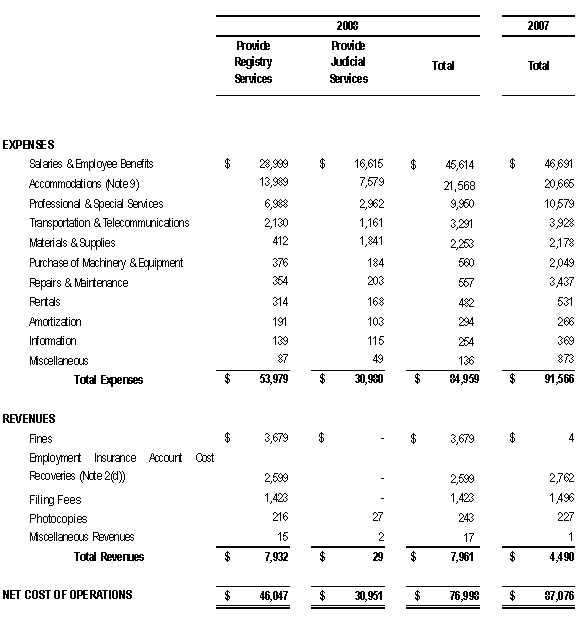
The accompanying notes form an integral part of these financial statements.
Courts Administration Service
Statement of Financial Position (Unaudited)
At March 31
(in thousands of dollars)
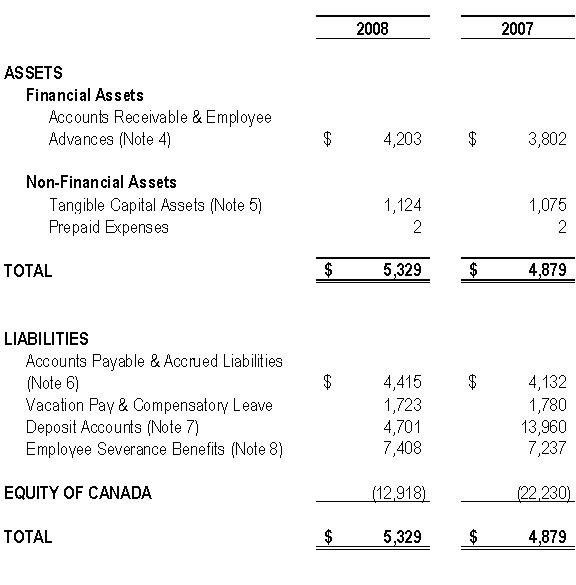
The accompanying notes form an integral part of these financial statements.
Courts Administration Service
Statement of Equity of Canada (Unaudited)
At March 31
(in thousands of dollars)
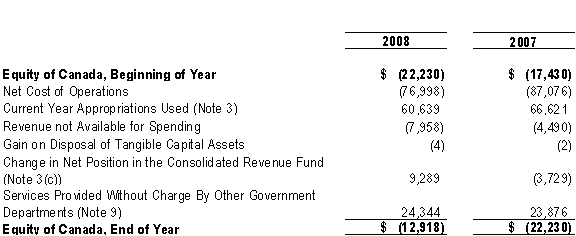
The accompanying notes form an integral part of these financial statements.
Courts Administration Service
Statement of Cash Flows (Unaudited)
For the Year Ended March 31
(in thousands of dollars)
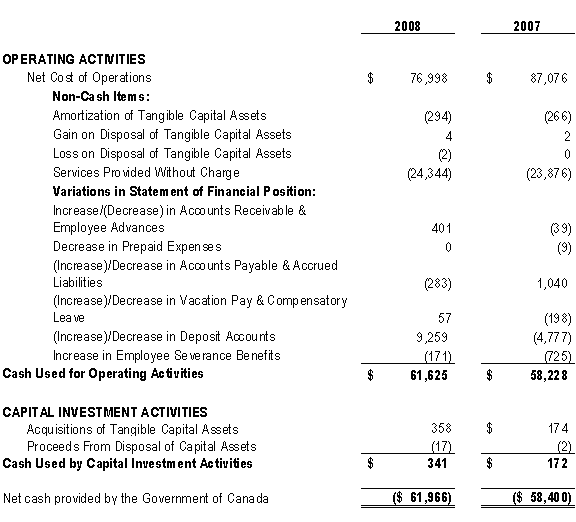
The accompanying notes form an integral part of these financial statements.
Courts Administration Service
Notes to the Financial Statements (Unaudited)
(in thousands of dollars)
-
Authority and Objectives
The Courts Administration Service (CAS), which was established on July 2, 2003 by the Courts Administration Service Act, S.C. 2002, c.8, is responsible for providing services to the Federal Court of Appeal, the Federal Court, the Court Martial Appeal Court of Canada and the Tax Court of Canada ("the Courts").
The role of the Courts Administration Service is to provide administrative services by ensuring that the public has effective, timely and fair access, in either official language, to the litigation processes of the Courts.
The Courts Administration Service has two service lines: to provide Registry services and to provide Judicial Services.
Registry Services provide administrative support to the Courts while ensuring the proper and efficient operations of the litigation process in a manner that provides the public with guidance and advice on the Courts' practices and procedures.
Judicial Services provide judicial, legal and administrative support to the Courts, which include but are not limited to judicial assistants, ushers, judicial administrators, law clerks and revisers who provide direct support to the Justices in the discharge of their responsibilities.
-
Summary of Significant Accounting Policies
The financial statements have been prepared in accordance with Treasury Board accounting policies which are consistent with Canadian generally accepted accounting principles for the public sector.
Significant accounting polices are as follows:
-
Parliamentary appropriations – the Courts Administration Service is solely financed by the Government of Canada through Parliamentary appropriations. Appropriations provided to the Courts Administration Service do not parallel financial reporting according to Canadian generally accepted accounting principles since appropriations are primarily based on cash flow requirements. Consequently, items recognized in the statement of operations and the statement of financial position are not necessarily the same as those provided through appropriations from Parliament. Note 3 provides a high-level reconciliation between the bases of reporting.
-
Net Cash Provided by Government – the Courts Administration Service operates within the Consolidated Revenue Fund (CRF), which is administered by the Receiver General for Canada. All cash received by the department is deposited to the CRF and all cash disbursements made by the department are paid from the CRF. The net cash provided by Government is the difference between all cash receipts and all cash disbursements including transactions between departments of the federal government.
-
Changes in net position in the Consolidated Revenue Fund is the difference between the net cash provided by Government and appropriations used in a year, excluding the amount of non-respendable revenue recorded by the department. It results from timing differences between when a transaction affects appropriations and when it is processed through the CRF.
-
Revenues :
-
Revenues consist primarily of filing fees, fines and sales of copies of filed documentation, including copies of judgements and/or orders. All such revenue is non-respendable, meaning it cannot be spent by the Courts Administration Service and is deposited to the CRF.
-
All revenues are accounted for in the period in which the underlying transaction or event occurred that gave rise to the revenues.
-
Employment Insurance (EI) Account of Canada: At the end of each fiscal year, CAS determines the cost associated with the administration of Employment Insurance cases. The total cost allocated by CAS for handling EI cases are expended against Human Resources and Skills Development Canada (HRSDC), the department responsible for the EI account. As such, HRSDC would show an EI expense and the Courts Administration Service would show an equivalent, non-respendable revenue item. The purpose of this accounting exercise is to more accurately reflect the total cost of running the federal government's EI program and it is strictly internal to the government.
-
-
Expenses – Expenses are recorded on the accrual basis:
-
Vacation pay and compensatory leave are expensed as the benefits accrue to employees under their respective terms of employment.
-
Services provided without charge by other government departments for accommodation, the employer's contribution to the health and dental insurance plans and legal services are recorded as operating expenses at their estimated cost.
-
-
Employee future benefits
-
Pension benefits: Eligible employees participate in the Public Service Pension Plan (Public Service Superannuation Act), a multi-employer plan administered by the Government of Canada. The Courts Administration Service's contributions to the Plan are charged to expenses in the year incurred and represent the total departmental obligation to the Plan. Current legislation does not require the Courts Administration Service to make contributions for any actuarial deficiencies of the Plan.
-
Severance benefits: Employees are entitled to severance benefits under labour contracts or conditions of employment. These benefits are accrued as employees render the services necessary to earn them. The obligation relating to the benefits earned by employees is calculated using information derived from the results of the actuarially determined liability for employee severance benefits for the Government as a whole.
-
-
Accounts Receivable – these are stated at amounts expected to be ultimately realized. A provision is made for receivables where recovery is considered uncertain.
-
Contingent Liabilities – Contingent liabilities are potential liabilities which may become actual liabilities when one or more future events occur or fail to occur. To the extent that the future event is likely to occur or fail to occur, and a reasonable estimate of the loss can be made, an estimated liability is accrued and an expense recorded. If the likelihood is not determinable or an amount cannot be reasonably estimated, the contingency is disclosed in the notes to the financial statements.
The Courts Administration Service is not aware of any contingent liabilities as at March 31, 2008.
-
Foreign currency transactions – Transactions involving foreign currencies are translated into Canadian dollar equivalents using rates of exchange in effect at the time of those transactions. Monetary assets and liabilities denominated in a foreign currency are translated using exchange rates in effect on March 31st.
-
Tangible Capital assets – All tangible capital assets having an initial cost of $5,000 or more are recorded at their acquisition cost.
Amortization of tangible capital assets is done on a straight-line basis over the estimated useful life of the assets as follows:
Asset Class Amortization period Machinery & Equipment 10 years Informatics Hardware 3 years Informatics Software 4 years Furniture & Fixtures 10 years Motor Vehicles 10 years
-
Measurement uncertainty – The preparation of these financial statements in accordance with Treasury Board accounting policies which are consistent with Canadian generally accepted accounting principles for the public sector requires management to make estimates and assumptions that affect the reported amounts of assets, liabilities, revenues and expenses reported in the financial statements. At the time of preparation of these statements, management believes the estimates and assumptions to be reasonable. The most significant items where estimates are used are contingent liabilities, the liability for employee severance benefits and the useful life of tangible capital assets. Actual results could significantly differ from those estimated. Management's estimates are reviewed periodically and, as adjustments become necessary, they are recorded in the financial statements in the year they become known.
-
-
Parliamentary Appropriations
The Courts Administration Services receives most of its funding through annual Parliamentary appropriations. Items recognized in the statement of operations and the statement of financial position in one year may be funded through Parliamentary appropriations in prior, current or future years. Accordingly, the Courts Administration Service has different net results of operations for the year on a government funding basis than on an accruals accounting basis. The differences are reconciled in the following tables:
-
Reconciliation of net cost of operations to current year appropriations used
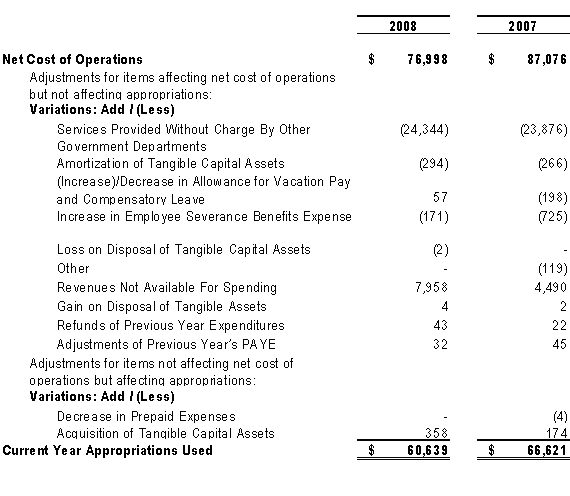
-
Appropriations Provided and Used
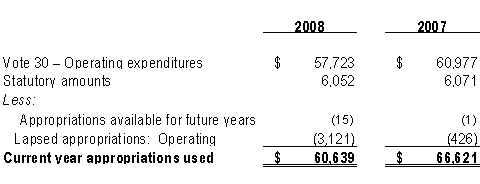
-
Reconciliation of net cash provided by Government to current year appropriations used
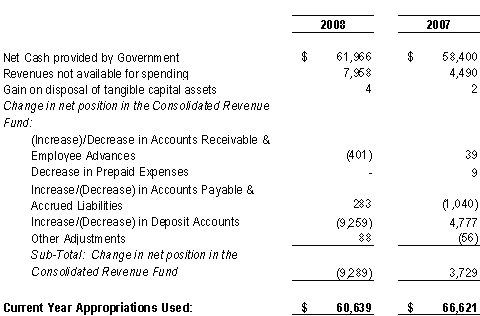
-
-
Accounts Receivable and Employee Advances
The following table presents details of accounts receivable and employee advances:
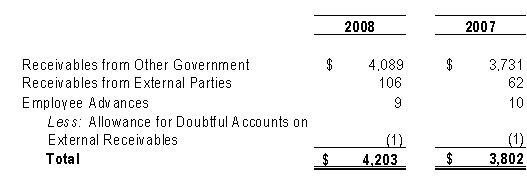
-
Tangible Capital Assets
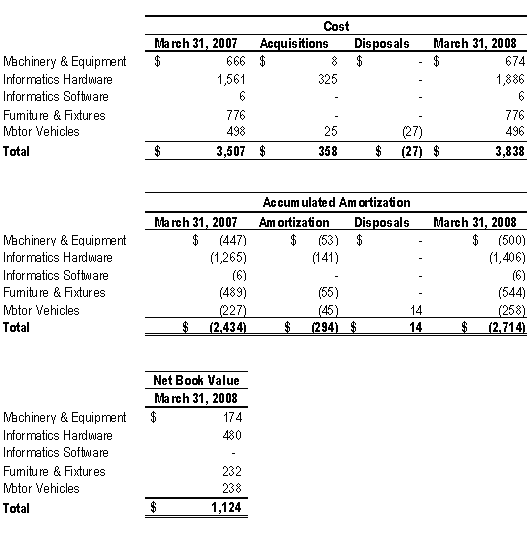
Amortization expense for the year ended March 31, 2008 is $294 (2006-2007 was $266).
-
Accounts Payable & Accrued Liabilities
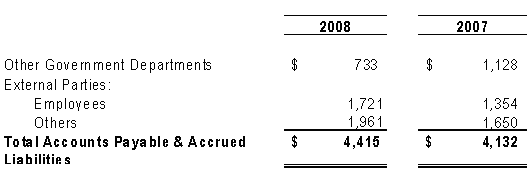
-
Deposit Accounts
The Courts Administration Service maintains two deposit accounts on behalf of litigants before the Court. Pursuant to an order of the Court, the deposit accounts will record moneys paid into the Federal Court of Appeal, Federal Court and Tax Court of Canada. These amounts are held as payments and eventually released, pending judgment of the Courts. The underlying differences of these two accounts are the calculation of interest as described below.
Calculation of Interest:
Deposit Account for the Federal Court of Appeal & Federal Court: Pursuant to the Order in Council P.C. 1970 4/2, the account earns interest semi annually at a rate that is equal to nine tenths of the monthly average of tender rates or three month Treasury bills and is calculated on the minimum monthly balance.
Deposit Account for the Tax Court of Canada: Pursuant to the Order in Council P.C. 1970 300, the account earns interest semi annually at a rate that is equal to ninety percent of the average of the weekly three month Treasury bills and is calculated on a daily basis.

-
Employee Benefits
-
Pension benefits: The Courts Administration Service's employees participate in the Public Service Pension Plan, which is sponsored and administered by the Government of Canada. Pension benefits accrue up to a maximum period of 35 years at a rate of 2 percent per year of pensionable service, times the average of the best five consecutive years of earnings. The benefits are integrated with Canada/Quebec Pension Plans benefits and they are indexed to inflation.
Both the employees and the Courts Administration Service contribute to the cost of the Plan. The 2007-2008 expense amounts to $4,399 which represents approximately 2.1 times the contributions by employees ($4,466 in 2006-2007 at a rate of 2.2 times).
The Courts Administration Service's responsibility with regard to the Plan is limited to its contributions. Actuarial surpluses or deficiencies are recognized in the financial statements of the Government of Canada, as the Plan's sponsor.
-
Severance benefits: The Courts Administration Service provides severance benefits to its employees based on eligibility, years of service and final salary. These severance benefits are not pre-funded. Benefits will be paid from future appropriations. Information about the severance benefits, measured as at March 31, is as follows:

-
-
Related party transactions
The Courts Administration Service is related as a result of common ownership to all Government of Canada departments, agencies and Crown Corporations. The Courts Administration Service enters into transactions with these entities in the normal course of business and on normal trade terms. Also, during the year, the Courts Administration Service received services which were obtained without charge from other Government departments as presented in part (a).
-
Services Provided Without Charge – During the year the Courts Administration Service department received, without charge from other departments, accommodations, legal fees, workmen's compensation and the employer's contribution to the health and dental insurance plan. These services provided without charge have been recognized in the Courts Administration Service's Statement of Operations as follows:
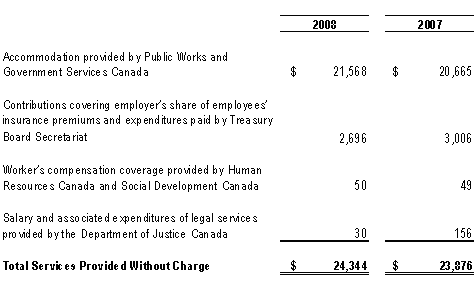
The Government has structured some of its administrative activities for efficiency and cost-effectiveness purposes so that one department performs these on behalf of all without charge. The cost of these services, which include payroll and cheque issuance services provided by Public Works and Government Services Canada, are not included as an expense in the Courts Administration Service's Statement of Operations.
-
Internal Transactions - The Courts Administration Service has made internal transactions of $2,910 to other government departments in the year ending March 31, 2008 and $3,075 in the year ending March 31, 2007. Of this amount, the Employment Insurance account Cost Recoveries account for $2,599 in 2007-2008 and $2,762 in 2006-2007 (Note 2(d)).
-
